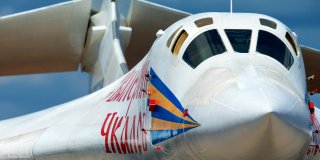Why Joe Biden Should Fear Russia's Record-Setting Tu-160 Bomber
The Soviet Air Force’s Tupolev Tu-160 “Blackjack” bomber was, and is, immense. It was built as the answer to America’s B-1 Lancer, but it remains the largest and heaviest Mach 2 bomber ever built, far exceeding its American nemesis.
The Soviet Air Force’s Tupolev Tu-160 “Blackjack” bomber was, and is, immense. It was built as the answer to America’s B-1 Lancer, but it remains the largest and heaviest Mach 2 bomber ever built, far exceeding its American nemesis.
While the bomber was masterfully designed and built, in terms of broader strategic considerations, it was too little, too late. The Tu-160 did not enter service until 1987, well into the Soviet Union’s glasnost and perestroika era; within two years, the writing was on the wall for the USSR, and no bomber could change that. But while the Tu-160 could not save the Soviet Union, it could set air records – lots and lots of air records, as it turned out. And it did.
On October 31, 1989, a Soviet aircrew flew a Tu-160 to set 21 World Air Sports Federation (FAI) records in the FAI’s Group 3 (turbojet aircraft) classification. Two of these were speed records over a 1000 km circuit; others included altitude records and speed records with various heavy payloads. Four days later, a different Soviet aircrew set another 21 FAI records, including maximum takeoff weight; the plane managed to get off the ground with a total weight of 275,000 kg (approximately 600,000 lbs).
The following May, on four different days, four different Soviet aircrews set a combined 36-speed records – 18 traditional speed records, and 18-speed records over 1000 and 5000 km closed circuits. More amazingly, the aircrews managed to perform these feats with only three people per plane, missing the usual aircrew of four. In the Soviet era, this brought the Tu-160’s total record capture up to 78 – a truly incredible total.
Perhaps in recognition of this incredible track record, the T-160 is still used by the modern Russian Air Force. The bomber has undergone significant upgrades over the past decade, mostly in their electronics systems. And while the planes are by no means new, they continue to set records. As recently as 2010, Russian aircrews set two new endurance records with the Tu-160, flying more than 18,000 km (approximately 11,000 miles) with the aid of two aerial refuelings.
The Russian Air Force continues to rely on the Tu-160. Perhaps one day, the planes will be replaced, but, judging from the amount of money that cash-strapped Moscow is putting into their upgrades, no new design seems imminent. And until they are replaced, their crews will doubtless continue to push them to score more records.
Trevor Filseth is a current and foreign affairs writer for the National Interest.

